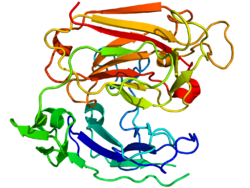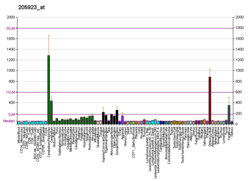Reelin, encoded by the RELN gene,[5] is a large secreted extracellular matrix glycoprotein that helps regulate processes of neuronal migration and positioning in the developing brain by controlling cell–cell interactions. Besides this important role in early development, reelin continues to work in the adult brain.[6] It modulates synaptic plasticity by enhancing the induction and maintenance of long-term potentiation.[7][8] It also stimulates dendrite and dendritic spine development in the hippocampus,[9][10] and regulates the continuing migration of neuroblasts generated in adult neurogenesis sites of the subventricular and subgranular zones. It is found not only in the brain but also in the liver, thyroid gland, adrenal gland, fallopian tube, breast and in comparatively lower levels across a range of anatomical regions.[11]
Reelin has been suggested to be implicated in pathogenesis of several brain diseases. The expression of the protein has been found to be significantly lower in schizophrenia and psychotic bipolar disorder,[12] but the cause of this observation remains uncertain, as studies show that psychotropic medication itself affects reelin expression. Moreover, epigenetic hypotheses aimed at explaining the changed levels of reelin expression[13] are controversial.[14][15] Total lack of reelin causes a form of lissencephaly. Reelin may also play a role in Alzheimer's disease,[16] temporal lobe epilepsy and autism.
Reelin's name comes from the abnormal reeling gait of reeler mice,[17] which were later found to have a deficiency of this brain protein and were homozygous for mutation of the RELN gene. The primary phenotype associated with loss of reelin function is a failure of neuronal positioning throughout the developing central nervous system (CNS). The mice heterozygous for the reelin gene, while having little neuroanatomical defects, display the endophenotypic traits linked to psychotic disorders.[18]
- ^ a b c GRCh38: Ensembl release 89: ENSG00000189056 – Ensembl, May 2017
- ^ a b c GRCm38: Ensembl release 89: ENSMUSG00000042453 – Ensembl, May 2017
- ^ "Human PubMed Reference:". National Center for Biotechnology Information, U.S. National Library of Medicine.
- ^ "Mouse PubMed Reference:". National Center for Biotechnology Information, U.S. National Library of Medicine.
- ^ "RELN gene". Genetics Home Reference. 1 August 2013. Retrieved 11 September 2022.
- ^ Bosch C, Muhaisen A, Pujadas L, Soriano E, Martínez A (2016). "Reelin Exerts Structural, Biochemical and Transcriptional Regulation Over Presynaptic and Postsynaptic Elements in the Adult Hippocampus". Frontiers in Cellular Neuroscience. 10: 138. doi:10.3389/fncel.2016.00138. PMC 4884741. PMID 27303269.
- ^ Cite error: The named reference
LTP1was invoked but never defined (see the help page). - ^ Cite error: The named reference
LTP2was invoked but never defined (see the help page). - ^ Cite error: The named reference
Niu_2004was invoked but never defined (see the help page). - ^ Cite error: The named reference
pmid18842893was invoked but never defined (see the help page). - ^ "Tissue expression of RELN - Summary - The Human Protein Atlas". www.proteinatlas.org. Retrieved 28 May 2018.
- ^ Cite error: The named reference
szconfirm1was invoked but never defined (see the help page). - ^ Cite error: The named reference
Schizophrenia Research Forum: Current Hypotheseswas invoked but never defined (see the help page). - ^ Cite error: The named reference
pmid17870056was invoked but never defined (see the help page). - ^ Cite error: The named reference
pmid18319075was invoked but never defined (see the help page). - ^ Kovács KA (December 2021). "Relevance of a Novel Circuit-Level Model of Episodic Memories to Alzheimer's Disease". International Journal of Molecular Sciences. 23 (1): 462. doi:10.3390/ijms23010462. PMC 8745479. PMID 35008886.
- ^ Cite error: The named reference
falconerwas invoked but never defined (see the help page). - ^ Cite error: The named reference
pmid16769115was invoked but never defined (see the help page).





